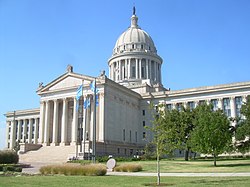Qualification, nomination, appointment and tenure of judges
Judges, at the time of their elections or appointments, must be at least thirty years old, must be registered voters in the Court of Criminal Appeals judicial districts they represent for at least one year before filing for the position, and must be licensed practicing attorneys or judges (or both) in Oklahoma for five years before their appointments. The potential judges must maintain their certifications as attorneys or judges during their tenures in office to main their positions. [6]
Potential Judges who meet these requirements must submit their names to the Oklahoma Judicial Nominating Commission to verify that they will serve if appointed. In the event of a vacancy on the Court of Criminal Appeals, after reviewing potential Justices, the commission must submit three named to the governor, out of whom, the governor appoints one of the three to the Court of Criminal Appeals to serve until the next general state election. However, if the Governor fails to appoint a Justice within sixty days, the Chief Justice of Oklahoma may appoint one of the nominees, who must certify his or her appointment to Secretary of State of Oklahoma. [7]
Judges of the Court of Criminal Appeals who are elected to retain their positions in the general state elections will continue to serve for another six years in office with their terms beginning on the second Monday in January following the general election. Justices appointed to fill vacancies take up office immediately and continue to serve in their appointed posts until the next general election. In order to be eligible to stand for reelection, Judges must, within sixty days before the general election, submit to the Secretary of State their desire to stand for reelection. [8]
Judges who stand for reelection are then put to election by the people of Oklahoma. If the majority vote to retain the judges, they will serve for another six-year term. However, when a judge declines to seek reelection or is defeated, the seat on the Court of Criminal Appeals shall be considered vacant at the end of the current term and the Judicial Nominating Committee must search for a potential replacement. Judges who have failed to file for reelection or were not retained by the people of Oklahoma in the general election are not eligible to immediately succeed themselves. [8]
Retention in office may be sought for successive terms without limit as to number of years or terms served in office. [8] Since 1907, every judge that has sought reelection has won.


